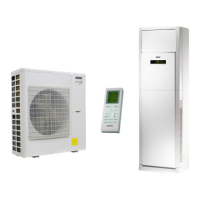4
1. WARNINGS
1.1. WARNINGS FOR THE FITTER
• The unit and its accessories must
only be installed and wired by pro-
fessionals with the necessary tech-
nical qualifications in installation,
conversion, extension and mainte-
nance of the systems and who are
trained to perform operational and
safety checks on these systems. In
this manual, these will generally be
referred to as “Personnel with spe-
cific technical skills”.
• This air conditioner must be in-
stalled according to national plant
engineering regulations. Particular
attention must be paid to safety
guidelines and to ensuring that
the wiring is correctly connected:
incorrect wiring connection could
result in supply cables, plug or pow-
er socket overheating, which could
present a fire risk.
• Ensure that the air conditioner is
connected to the power supply or
to a power socket with the correct
voltage and frequency. Using pow-
er supplies with the incorrect volt-
age and frequency could dam-
age the unit and consequently risk
starting a fire. The voltage must be
stable, without major fluctuations.
• Install on a solid surface which can
bear the weight of the air condi-
tioner. Check the support is secure-
ly installed and the unit is absolutely
stable after operating for a long
time.
• To protect the unit against short
circuits, fit a thermomagnetic isola-
tor switch to the power line with a
minimum contact gap of 3mm on
both poles.
• The isolator switch and any plug
must be installed in an easily acces-
sible position.
• To ensure good drainage, the con-
densate discharge pipes must be
correctly installed, following the
installation instructions. Adopt the
most suitable measures to avoid
heat dispersion and the conse-
quent formation of condensate. In-
correct installation of the pipes can
result in water leaks, wetting furni-
ture and other items in the room.
• Do not install the unit in a location
where it could be affected by in-
flammable gas leaks or deposits of
materials which are inflammable,
explosive, poisonous, corrosive or
hazardous substances. Do not use
naked flames near the units. Risk
of fire or explosion. Install the unit
in a location with minimal levels of
dust, fumes, humidity and corrosive
agents in the air.
• Do not install in laundries.
• When installing the unit, allow suffi-
cient technical clearance around
the unit for maintenance.
• When installing the unit, ensure
that the dimensions and weight of
the unit are visible. Respect the di-
mensions stipulated in this manual
with regards to the refrigerant line
length, the height difference be-
tween the units, and the siphons to
install along the refrigerant lines.
• For the outdoor unit, choose a lo-
cation where the noise and air jets
will not disturb the neighbours.
• For the outdoor unit, choose a lo-
cation which will not disturb the
flow of pedestrians and which is in
accordance with local architectur-
al regulations.
• Avoid obstructing the air flow in and
out of the indoor and outdoor units.
• Do not make any modifications to
the unit! Do not attempt to repair
the unit alone, this is extremely dan-
gerous! Incorrect operations could
cause electric shocks, water leaks,
fires etc. Contact your After Sales
Service, these operations must only
be carried out by “Personnel with
the specific technical skills”.
• Ensure that the power supply and
the installed output are adequate-
ly scaled to supply the air condi-
tioner correctly.
• Before operating the air conditioner,
ensure that the electric cables, con-
densate discharge pipes and cool-
ing connections have been correctly
installed to avoid the risk of water
leaks, refrigerant gas leaks and elec-
tric shocks.
• The air conditioner must be cor-
rectly earthed. Do not connect
the earth cable to the gas or water
pipes, to the lightning conductor,
or to the earth cable of the tele-
phone. Incorrect earthing could
cause electric shocks.
• Do not handle the air conditioner
or touch the keys with wet hands.
Risk of electric shocks.
• The unit and the isolator switch
must be turned off before carrying
out maintenance work or cleaning.
The rotation of the fans inside the
unit can cause injury.
• Check that the power supply is
disconnected before carrying out
any operations on the unit.
• Do not place objects on the out-
door unit and do not climb on top
of it.
• For the power supply, use undam-
aged cables with a section that is
suitable for the load.
• Stranded cables can only be used
with crimping terminals. Check the
wire strands are well inserted.
• Take care when stretching the sup-
ply and connection cables around
the units: the cables must not be
subject to mechanical stress. The
PURPOSE OF THE UNIT:
Split-system air conditioners are
designed solely for the purpose
of air conditioning indoor rooms
of a certain size and with the
conditions of use appropriate to
the installed output. DO NOT USE
THESE UNITS FOR OTHER PURPOSES.
The heat pump versions can be
operated for heating or cooling
purposes.
Split-system air conditioners are
composed of two main units
which must be connected during
the installation process.
The indoor unit of a split-system
air conditioner is the element
which diffuses treated air into the
room to be air conditioned: do
not install this unit outdoors.
The outdoor unit of a split-system
air conditioner is the element
which draws out heat from in-
doors, expelling it outside (Cool-
ing mode); it also absorbs heat
from outside to heat the rooms
indoors (Heating mode). Install
outdoors.
The operating management of
the various air conditioner models
is performed via remote control or
panel on the machine

